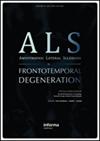Serum urate at trial entry and ALS progression in EMPOWER
IF 2.8
4区 医学
Q2 CLINICAL NEUROLOGY
Amyotrophic Lateral Sclerosis and Frontotemporal Degeneration
Pub Date : 2017-01-02
DOI:10.1080/21678421.2016.1214733
引用次数: 21
Abstract
Abstract Our objective was to determine whether serum urate predicts ALS progression. A study population comprised adult participants of EMPOWER (n = 942), a phase III clinical trial to evaluate the efficacy of dexpramipexole to treat ALS. Urate was measured in blood samples collected during enrollment as part of the routine block chemistry. We measured outcomes by combined assessment of function and survival rank (CAFs), and time to death, by 12 months. Results showed that in females there was not a significant relation between urate and outcomes. In males, outcomes improved with increasing urate (comparing highest to lowest urate quartile: CAFS was 53 points better with p for trend = 0.04; and hazard ratio for death was 0.60 with p for trend = 0.07), but with adjustment for body mass index (BMI) at baseline, a predictor of both urate levels and prognosis, associations were attenuated and no longer statistically significant. Overall, participants with urate levels equal to or above the median (5.1 mg/dl) appeared to have a survival advantage compared to those below (hazard ratio adjusted for BMI: 0.67; 95% confidence interval 0.47–0.95). In conclusion, these findings suggest that while the association between urate at baseline and ALS progression is partially explained by BMI, there may be an independent beneficial effect of urate.试验开始时的血清尿酸和EMPOWER患者的ALS进展
我们的目的是确定血清尿酸是否能预测ALS的进展。研究人群包括EMPOWER (n = 942)的成年参与者,这是一项评估右帕克索治疗ALS疗效的III期临床试验。作为常规阻滞化学的一部分,在入组期间收集的血液样本中测量尿酸盐。我们通过综合评估功能和生存等级(CAFs)以及12个月的死亡时间来衡量结果。结果显示,在女性中,尿酸与预后之间没有显著关系。在男性中,结果随着尿酸浓度的增加而改善(比较最高和最低尿酸浓度四分位数:CAFS提高53分,p为趋势= 0.04;死亡的危险比为0.60 (p为趋势= 0.07),但调整基线体重指数(BMI)后,相关性减弱,不再具有统计学意义。BMI是准确水平和预后的预测因子。总体而言,尿酸水平等于或高于中位数(5.1 mg/dl)的参与者似乎比低于中位数的参与者有生存优势(BMI调整后的风险比:0.67;95%置信区间0.47-0.95)。综上所述,这些研究结果表明,虽然基线尿酸水平与ALS进展之间的关联可以部分由BMI解释,但尿酸水平可能有独立的有益作用。
本文章由计算机程序翻译,如有差异,请以英文原文为准。
求助全文
约1分钟内获得全文
求助全文
来源期刊

Amyotrophic Lateral Sclerosis and Frontotemporal Degeneration
CLINICAL NEUROLOGY-
CiteScore
5.40
自引率
10.70%
发文量
64
期刊介绍:
Amyotrophic Lateral Sclerosis and Frontotemporal Degeneration is an exciting new initiative. It represents a timely expansion of the journal Amyotrophic Lateral Sclerosis in response to the clinical, imaging pathological and genetic overlap between ALS and frontotemporal dementia. The expanded journal provides outstanding coverage of research in a wide range of issues related to motor neuron diseases, especially ALS (Lou Gehrig’s disease) and cognitive decline associated with frontotemporal degeneration. The journal also covers related disorders of the neuroaxis when relevant to these core conditions.
 求助内容:
求助内容: 应助结果提醒方式:
应助结果提醒方式:


